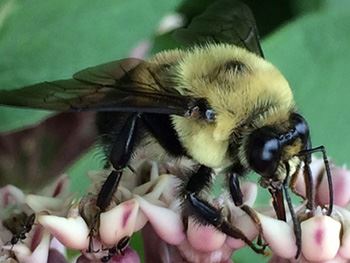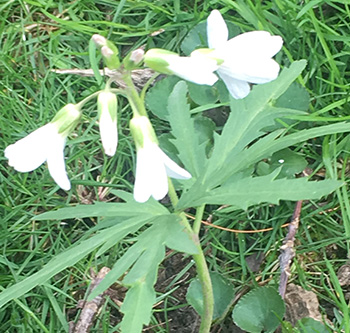Flight of the Bumble bee

After a long winter’s nap, the queen bumble bee emerges from her underground throne on the first warm days of spring. Hibernating for many months in old rodent burrows, grass tussocks, or among rock crevices, large compound eyes now patrol the forest floor for floral jewels full of pollen and nectar. She flies low over the ground like a mini drone buzzing along, landing at different sites to investigate abandoned holes and hollow logs. Her main task in life is a big one---to keep the species going strong. Each year, individual queens must survive the winter, then will awaken early to build up important energy stores essential for establishing a new colony in the appropriate natural habitat.
The key to continued survival is the right combination of biologic essentials, such as sources for both spring and summer nectar and pollen, as well as underground nesting sites all in the right habitat. Not wanting to expend huge amounts of energy foraging on a cool spring day, queens make short-distance flights into adjacent woodlands seeking important nutrition from native spring wildflowers, such as trout lily, purple cress, toothwort, wild geranium, trillium, may apple and spring beauty. Native willow and serviceberry trees are also used as food sources.
After carefully choosing her site in the right location---safely hidden away, she lays her first clutch of eggs on a cluster of pollen covered with nectar in a small wax cup. The young feeds on this pollen while she alternates between incubating the larvae and foraging for more food as the colony grows. Throughout the summer, the new worker bees will need access to nearby nectar sources and will rely on summer and fall natives such as wild bergamot, Virginia mountain mint, ironweed, milkweed, goldenrods and asters.
There are approximately eight species of bumble bees that may be encountered in northwest Ohio. However, many of these pollinators have declined, and some species are now difficult to find. Continued success for these species relies on the quality of our natural areas, as well as a diverse amount of native plant offerings in our own landscapes and gardens.
Each year, Metroparks manages many acres of natural areas through the removal of invasive species, propagates a diverse amount of species of native plants, and works to continually add these important pollinator species to restored sites. These areas which are adjacent to many Metropark woodlands packed with the right kind of spring sustenance for the queens, help to provide the key to success for these important pollinator species. As you walk a trail in the Metroparks this spring, look for a queen bee flying low and think about incorporating native plants rich in pollen and nectar in your landscape to support bumblebees.
Did you know? Bumble bee species have different tongue lengths adapted to foraging from different types of flowers.

Image: Cut-leaved Toothwort